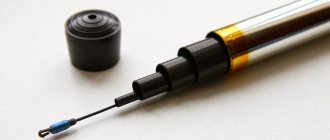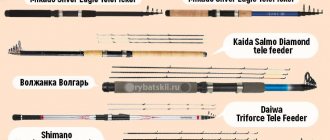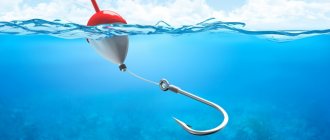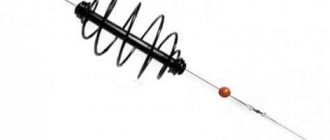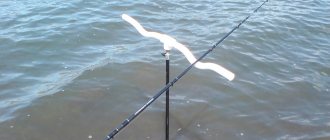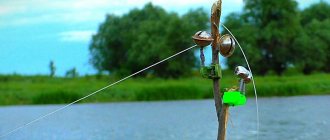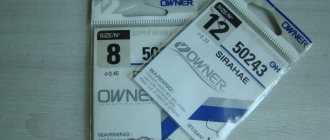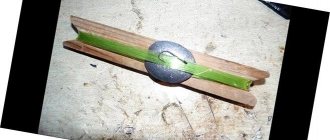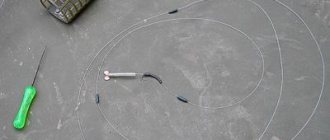Assembling your own spinning rod is profitable
You can catch large fish with a spinning rod and actively participate in the process of catching it. This will require physical force. Often fishermen have to walk 5-6 kilometers a day and constantly cast gear.
At first you will think that this activity is boring, but once you get the hang of it and find the perfect spinning rod, you won’t be able to stop.
Beginners in this business do not want to splurge on expensive products. Therefore, you can always find instructions for creating:
- Reel seat for any spinning rod;
- Leashes made from scrap materials;
- Reel holder for tackle.
The easiest way to make a spinning rod with your own hands is from wood or bamboo.

Bait, groundbait and methods of its delivery
Any bait and bait can be used, but it is worth considering that for bottom fishing, animal baits are more suitable, which stand out at the bottom not only by smell, but also by movement.
The use of bait is influenced by both the target fish and the time of year. Both homemade compositions and store-bought bait, as well as their combinations, can be used equally successfully.
If it is possible to feed the fishing point by hand, or using a slingshot, it is better to give preference to these methods, since in this case it is possible to somewhat reduce the load on the spinning rod, which, when used as a rod, is often overloaded.
Spinning rod made of wood
Materials and tools needed to create:
- Thick wooden stick. A ski pole with a length of 80 cm is suitable;
- Whips. Made from fiberglass or carbon fiber. The length should reach 1 meter. You can buy it in sports stores;
- A sleeve whose diameter matches the diameter of the stick;
- Solid foam;
- Glue “Moment” or “Super cement”;
- File or sandpaper;
- 2 metal rings, the thickness of which should be 2-3 mm, and the diameter - 1-1.5 cm;
- 3−4 access rings;
- A tulip, which you can buy in fishing stores or make yourself from the cage of a small ball bearing;
- Nitrolac;
- Thread bandage. Can be purchased at fishing stores.
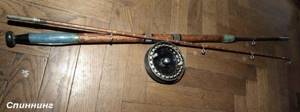
Now you can start assembling the future spinning rod:
- First, prepare your ski pole: sand it thoroughly with a file or sandpaper; After this, connect its upper part with a pre-prepared sleeve. This is the basis of the future fishing rod, which needs a strong handle;
- You can choose the material for the handle yourself. However, the best option is to use rigid foam. When fishing, the tackle will not slip out of your hands. You need to make small cylinders from polystyrene foam, the thickness of which will be about 2-3 cm, and the diameter - 2.5-3 cm;
- Use a drill to make holes in them. The thickness of the cylinders should be such that the base of our shaft fits tightly and is secured;
- Then, using “Moment” or “Super Cement” glue, you need to lubricate our prepared rod base and insert it into the handle parts;
- As soon as the product dries, the handle needs to be sanded well, bringing its thickness to the one that will be ideal for your hand;
- Next, take the metal rings. If you couldn’t find them in a store, you can make them from an old vacuum cleaner tube by cutting pieces of a certain thickness. The result is a convenient reel seat attached to the spinning rod;
- The rings need to be secured to the handle of the future fishing rod using superglue, and the reel should be inserted onto them;
- Next, take the tulip and use glue to place it on the tip of the ski pole;
- Attach 3-4 guide rings to the rod. The distance between them should be the same;
- Additionally, secure the metal rings with a thread bandage, and then treat them with nitro varnish.
Characteristics of a spinning rod
Before you start assembling spinning tackle, you need to decide on the type of fishing rod and its parameters. A beginner should be strict about his choice and carefully consider some parameters.
- Rod length - the choice of length is individual, depending on the fishing location and the casting distance. If casting will take place mainly from a boat, then the best choice would be a rod up to two meters long. Also, the length of 2.5 meters is perfect for beginners.
- Flexibility - There are several types of action, depending on where the rod bends. The even bend throughout the rod makes it clear that this is a slow action rod. The bend of the rod tip is a fast action; An excellent choice for beginners would be the golden mean - medium tuning. The action is considered average if the rod is deformed mainly in the center.
- Rod test - this important parameter is usually indicated on the rod; it shows the appropriate weight of the lures. Beginners should be more careful in their equipment and use baits that match the test rod, otherwise the rod may be broken or severely damaged.
- Rings are a technology for manufacturing guide rings; their quality is very important for a fisherman, because the durability of the fishing rod depends on it.
- Handle - the length of the handle is selected according to the taste of the fisherman. The handle needs to be selected so that, with its configuration, it fits perfectly in the hand - this will make fishing comfortable.
Parts such as the reel, holder, guide rings and handle are very important and should not be skimped on by beginners. When buying a spinning rod, you should ask for advice from an experienced fisherman, seller, or look up information on the Internet.
All modern spinning rods vary in length, test, class and action.
Spinning test
The test characteristics of the rod are considered basic. It is indicated in grams, which are applied to the body of the rod and determines the upper and lower limits of the mass of the bait used. There are several main classes. For example:
- Light class (Light) – 5-15 grams.
- Middle class (Medium) – 10-30 grams.
- Heavy class (Heavy) – 20-50 grams.
- Extra Heavy class – more than 50 grams.
In addition to the main classes, the following intermediate classes are noted:
- Ultra Light class – 0-10 grams.
- Medium Light class – 5-25 grams.
- Medium Heavy class – 15-40 grams.
In general, it is recommended not to exceed the test limits. If all the baits are lighter than the lower limit, then it will be difficult to cast the bait over a significant distance, and if it weighs more than the upper limit, then it is unlikely that you will be able to control the bait during the retrieving process.
In addition, baits that are heavier than indicated in the test can damage the rod. Mostly the tip breaks.
Then it will be difficult to choose a tip for a specific rod.
Spinning rod length
Length is an equally important characteristic that can affect the performance of spinning fishing. Basically, the length of a rod is measured in meters, but if it is an American rod, then in feet and inches.
First you need to decide for what fishing conditions the fishing rod is selected. You can fish with a spinning rod either from the shore or from a boat. In this case, it is better to focus on universal gear that could be used in any conditions. Unfortunately, this is quite difficult to achieve, but it is necessary to strive for it.
For fishing from the shore, spinning rods with a length of 2.7 m perform well, and for a boat – from 2.1 m. Although sometimes, when there are thickets along the banks of a reservoir, a long spinning rod will be a hindrance. In such conditions it is better to use short spinning rods.
The material from which the spinning rod is made is of great importance. Considering the fact that you have to throw the tackle into the water quite often, it will be good if it has minimal weight. A good option is composite or carbon rods.
On sale you can find telescopic or plug-in forms. Plug rods are more reliable, but less practical as they are (relatively) difficult to transport. This is where telescopic rods win: they can be folded and placed in a regular bag, which is very practical. If you have a personal car, you can take a plug-in one - there will be no special problems during transportation.
For a beginning spinning player, a blank with a fast action is suitable, as it allows you to quickly respond to bites. A slower action is harder to jig and twitch, which requires special skill.
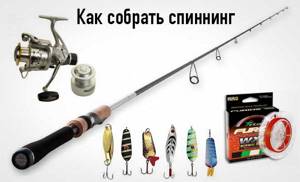
To begin with, you can take a rod with a test from 10 to 40g, although such a rod will be difficult to find. In general, you need to have 2 rods: one for ultralight lures with a test weight of up to 15g and the second for heavier lures with a test weight from 15 to 30g. In this way you can organize the versatility of spinning fishing.
Bamboo spinning rod
According to many experienced fishermen, a bamboo rod is perfect for sport fishing. It is recognized as one of the best materials for creating fishing rods.
Professionals recommend creating it from several knees at once, since bamboo is not a cone-shaped plant. It is also impossible to make tackle from natural bamboo without pre-treatment. When fishing, severe deformation of the shaft or bending of the knots may occur.
Heat treatment will help: place the bamboo in boiling water for several hours to increase the strength of the material.

To make a spinning rod with your own hands, you need to prepare:
- Connecting tube made of high quality metal. Brass or aluminum are best. These materials have high strength and are not subject to premature corrosion. The diameter of the tube should be slightly smaller than that of bamboo;
- Gas or kerosene burner;
- Glue "Moment";
- 2 metal and 3 pass rings;
- Solid foam or several cork rings;
- Tulip.
Once all the products have been prepared, you must:
- Insert the tube into the bamboo;
- Then you need to heat the workpiece to ensure a firm fit of the tube in the bamboo. To do this, you can use a gas burner. The product must be heated at a distance of 15 cm to prevent the bamboo from overheating or charring;
- Also, the top of the future rod needs to be crimped using a smooth metal object;
- As soon as the products are firmly attached to each other, the metal tube must be lubricated with superglue and inserted into the hole of the bamboo;
- Additionally, warm up the elbow joints. Spend 4 minutes warming each one up;
- Next, the future fishing rod must be cooled at room temperature for 4 hours;
- After this, prepare a handle from hard foam or thick cork rings: drill holes in them, the rod will be inserted into them;
- Then use superglue to connect the two parts;
- Fill the rod with wood shavings through the top so that moisture does not accumulate inside and the tackle does not lose its elasticity;
- After this procedure, lubricate the workpiece with nitro varnish and let it harden;
- Attach guide rings and a tulip to the rod, and metal rings with a reel to the handle.
fishing line
After choosing a spinning rod and a reel, all that remains is to equip it with fishing line. There are two main types of thread - monofilament and braided. The first has the following advantages:
- low cost;
- absorbs fish jerks well;
- less noticeable in water.
However, monofilament has a lower breaking load and reduces the overall sensitivity of the gear.
Braided thread is more popular today than nylon, and is used in most modern fishing methods, such as jigging, twitching, topwater fishing and spaced rigs.
The main advantages of the cord are as follows:
- high strength;
- inextensibility, increasing the sensitivity of the gear;
- smaller diameter in relation to monofilament of the same diameter.
Experienced anglers fish with both braided and monofilament lines, using them depending on the situation. The latter, by the way, is much more expedient to use with rotating and oscillating spoons, since it rotates less with the reel.
Fluorocarbon line must be mentioned. In terms of its qualities, it is closer to monofilament. However, it is almost invisible in water, its strength indicators are lower, and its abrasion resistance is higher. Therefore, flurry is used as a leader material when hunting for pike, perch, asp, chub and trout.
How to assemble a spinning rod for different fishing conditions
When assembling gear yourself, you need to take into account a huge number of conditions. The finished product must be suitable for fishing conditions. The main criteria are:
- Size and weight of fish caught;
- Types of baits that are planned to be used, as well as methods of wiring them;
- Planned fishing distance;
- Place of fishing, its conditions, type of reservoir.
When creating gear, you need to take into account its length and weight. These parameters must be balanced for the fishing technique to be effective.
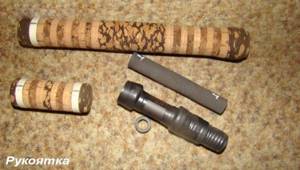
Once you have created the perfect rod, you need to test it in different conditions.
Prepare your bait in advance. Their weight should be:
± 10 g; ± 15 g; ± 25 g; ± 50 g (for this you can use a microjig spinning rod); ± 250 g (if heavy-duty sticks were used to create the fishing rod).
Spinning lures
A spinning rod is a special fishing rod that is designed for fishing for predatory fish. Spinning fishing is a special event for which you need to prepare. You need to know how to properly assemble a spinning rod, you need to be able to equip it. You even need to throw a spinning rod in a special way.
A well-equipped spinning rod is the key to successful fishing, so you need to figure out what gear is needed and how to put it all together into a single structure that will bring you a catch.
What types of spinning rods are there?
Spinning rods are folding rods that come in two types.
- Telescopic.
- Composite.
A telescopic spinning rod consists of many sliding parts, and a composite spinning rod is usually assembled from two parts.
A spinning rod has flexible and elastic properties, which facilitates long casts. There are spinning rods with different lengths for different purposes. Their length starts from one and a half meters. This spinning rod is convenient to use for fishing from a boat. Longer spinning rods, up to three and a half meters, are needed for fishing from the shore.
What is needed to build a spinning rod
Each predatory fish will have its own spinning rod assembly nuances. But there are generally accepted standards for all gear, without which it is impossible to do. So the list of necessary acquisitions needs to be taken into account.
This is the necessary minimum set of tools that will be needed for proper spinning for predatory fish.
When choosing a fishing rod when purchasing, you need to pay attention to such an important characteristic as the test. It is the test that shows what kind of load the tackle can withstand when casting. The data is given in grams and contains information about the smallest and largest weight of the load.
A properly assembled fishing rod is the key to a good catch.
- fishing rods;
- coils;
- cargo;
- fishing lines;
- hook;
- float
Some fishermen save on purchasing a reel by replacing it with a reel. However, on the modern market there are so many similar products at different prices that anyone can find gear they can afford. All necessary equipment must be purchased before properly assembling the fishing rod.
- A fly-type rod used in small bodies of water.
- Bolognese type rod, most comfortable for beginners.
- A match-type rod designed for long-distance casting.
- Plug type rod.
Coils can be inertial or non-inertial. The first type is a budget version and is more suitable for fishing over cliffs rather than for casting into the distance.
The most important thing when using an inertial reel is not to forget to snap the latch, because otherwise the line will inevitably get tangled.
The second type of reel is excellent for long-distance casting. They are suitable for various types of fishing rods and spinning rods and have many additional features that make fishing easier.
Typically, spinning tackle requires the following components:
- spinning rod;
- coils;
- fishing lines;
- artificial bait.
There are 3 main types of spinning baits:
- Silicone baits.
- Spoons.
- Wobblers.
There are several spinning equipment:
- The bait is attached directly to the swivel.
- A metal leash is used to connect the bait.
- A retractable leash is an equipment for bottom fishing.
- A drop shot is a rig for fishing from a high bank or from a boat.
- Sbirullino is a heavy float that allows you to throw light bait over considerable distances.
How to equip a spinning rod for pike?
The main elements of spinning tackle are:
- rod;
- inertia-free or multiplier reel;
- fishing line or braided cord;
- leash;
- bait;
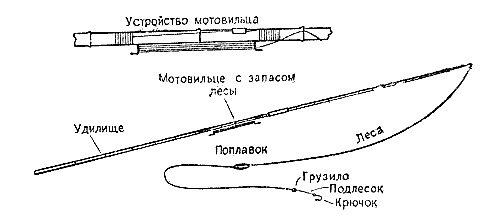
Let's celebrate! Each of these elements has its own functions and plays a big role in the reliability and functionality of the gear as a whole.
A spinning rod is a composite whip (blank), on which it is located with a handle with a locking device for the reel and a row of guide rings evenly spaced in the working part
For each of the baits used in spinning fishing, different types of equipment are used, including the length, action and test of the rod, the type and thickness of the fishing line, the presence, material and length of the leash.
How to equip a spinning rod with a wobbler?
- rod - fast or ultra-fast action, 180-210 cm long with a test weight from 15 to 20-25 g;
- fishing line - braided cord with a cross-section of up to 0.18-0.20 mm;
- leash – thin tungsten, up to 15-20 cm long.
How to equip a spinning rod with a spinner?
- rod – fast or medium action, length 240-270 cm with a test weight from 15 to 30-40 g;.
- fishing line - monofilament fishing line with a cross-section of up to 0.3-0.35 mm or braided cord with a cross-section of up to 0.20 mm;
- leash – thin tungsten or metal, up to 15-20 cm long.
How to equip a spinning rod with a feeder?
- rod - fast action, length from 330 (for lakes and ponds) to 390-420 cm (for rivers) with a test from 60-90 (for standing water) to 120-150 g. (when fishing in the current);
- fishing line - braided cord with a cross-section of up to 0.20-0.25 mm for the main fishing line, monofilament with a cross-section of 0.25-0.3 mm for the shock leader;
- feeder - rectangular metal weighing from 40 to 100-120 g;
- leash – a piece of monofilament fishing line with a cross-section of up to 0.18 mm and a length of up to 50 cm with hook No. 10-8.
Jig rigs for spinning
Silicone jig baits are connected to a line and sinker using several common rigs:
- the bait is put on a solid jig head with a hook;
- The bait is put on a simple or offset hook to which a collapsible Cheburashka sinker is hingedly attached.
Also, jig baits are used for such installations as:
- Texas rig - a twister or vibrohook mounted on an offset hook is tied to a leash made of monofilament fishing line up to 100 cm long. At the point where the leash and the main line are attached, a sliding bullet weight is installed, the movement of which towards the leash is limited by a stopper bead;
- Carolina rig - unlike the previous one, in this rig the bullet-shaped sliding sinker is placed directly on the leash with the bait;
- branch leash - a piece of monofilament about 30 cm long with a drop-shaped sinker weighing up to 14-16 grams is tied to one of the branches of the triple swivel. at the end, a leash made of the same monofilament up to 120 cm long is tied to the perpendicular branch; at the end there is a hook with a silicone bait attached to it. The main line is tied to the last branch.
Pike can be caught all year round using mugs, girders, float rods and spinning rods.
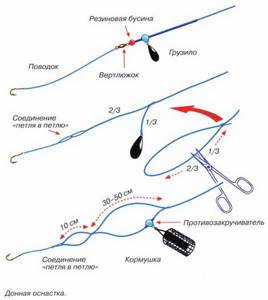
Among fishermen it is believed that spinning fishing is the most popular and interesting type of this hobby.
For any fisherman, the simplest item for catching pike on lakes, ponds, gentle rivers, as well as reservoirs is a float rod.
There are three most famous methods of spinning fishing:
- Jig – involves the use of special jig baits with a front loading. The bait can be carried out in any layers of water or at the very bottom.
- Twitching is a method that uses baits such as wobblers and poppers and involves moving the bait with jerks, which are carried out with the tip of the rod.
- Spinner - with this fishing method, widely known baits are used, in the form of oscillating and rotating spinners. Both uniform (for rotating spinners) and stepped (for oscillating spinners) wiring is possible.
Beginner's choice: jig and spinner.
Main parts of the spinning rod
Once you have assembled the spinning rod yourself, you need to take care of its main parts - the reel and fishing line.
Coil
In many fishing stores you can find the following varieties:
- Inertial. Not popular: using them to cast correctly is difficult;
- Inertialess. They are popular among novice anglers and hobbyists;
- Animators. Professional reels that are used for catching large fish, as well as for casting over long distances.
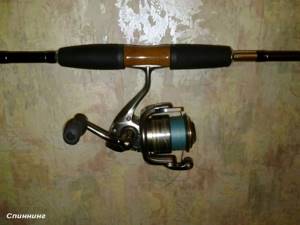
Coil
The next key element of gear, without which it is impossible to equip a spinning rod. A reel is needed for storing fishing line, casting and retrieving bait, and landing fish. By design it happens:
- inertialess;
- cartoon.
For beginners, an inertia-free fishing rod is needed; a multiplier is the choice of advanced fishermen, since it is much more difficult to operate.
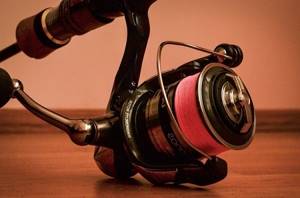
A beginner should start mastering spinning tackle with a spinning reel
All spinning reels are divided by size and gear ratio. According to the first indicator there are:
- ultralight;
- light;
- medium;
- heavy.
According to the reduction, the coils are power, universal and high-speed. When choosing a basic kit, it is better to equip it with a light or medium model with a gear ratio of about 5.0:1.
